For seafood enthusiasts, the endless variety of flavors and textures from oceanic delights is simply irresistible. From sushi and ceviche to oysters and clams, raw seafood is commonly enjoyed as an exquisite culinary experience. However, amid the celebration of these delicacies is a less common debate: can you eat raw crab? This question may arise from curiosity or cultural differences. Still, it’s crucial to clearly understand the potential risks and rewards of consuming this ocean creature in its most natural state.
In this article, we explore the world of raw crab consumption, examining the possible health implications, traditional dishes, and food safety precautions to be aware of when diving into this seemingly uncharted territory. So, whether you are a seasoned seafood lover or someone intrigued by the notion of trying raw crab, let’s uncover the shell and delve into this mystery together.
What Is Crab Meat?
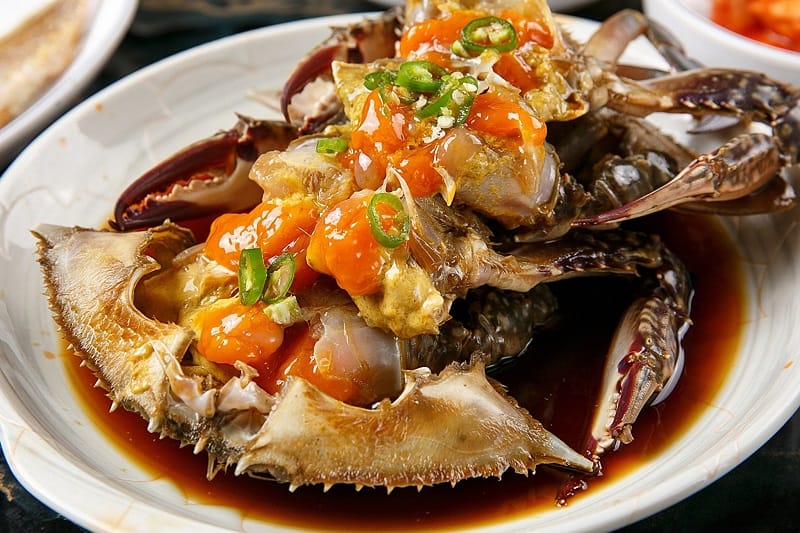
As someone with experience and expertise in the culinary world, I’m often asked about different types of seafood. One question that comes up frequently is, “What is crab meat?” Well, my friends, I’m here to give you all the ins and outs of this delicious delicacy.
First things first, let’s talk about where crab meat comes from. As you might have guessed, it comes from crabs! More specifically, it comes from the meat inside the crab’s body. This meat can be found in various crab parts, including the legs, claws, and body.
Now, not all crab meat is created equal. There are a few different types of crab meat that you might come across:
- Lump crab meat: This is the highest quality crab meat you can find. It comes from the crab’s body and is made up of large, meaty chunks.
- Claw meat: As the name suggests, this meat comes from the crab’s claws. It tends to be tougher and less sweet than lump crab meat, but it’s still delicious.
- Jumbo lump crab meat: This is similar to lump crab meat, but the chunks are even bigger. It’s quite rare and expensive, but oh so worth it.
- Backfin crab meat: This meat comes from the body of the crab, but it’s made up of smaller pieces than lump crab meat. It’s still delicious and tends to be a bit less expensive.
- Special crab meat: This is a mix of different types of crab meat, including lump, backfin, and claw meat. It’s a good option if you’re looking for a more affordable option that tastes great.
So, now that you know all about the different types of crab meat, let’s talk about how to cook with it. Crab meat is incredibly versatile and can be used in various dishes. Some popular options include crab cakes, crab dip, crab salad, and crab soup.
When cooking with crab meat, it’s essential to handle it gently to avoid breaking up the chunks. It’s also important to make sure you’re using fresh crab meat. If you’re buying it from a fish market, ask when it was caught and how it was stored.
In terms of flavor, crab meat has a sweet, delicate taste that pairs well with a variety of seasonings and sauces. Some popular options include Old Bay seasoning, lemon juice, and garlic butter.
So, you have everything you need to know about crab meat! Whether you’re a seasoned seafood lover or a newbie to the culinary world, you can’t go wrong with this delicious delicacy.
Can You Eat Raw Crab?
Eating raw crab is unsafe as it can contain harmful microorganisms such as bacteria and parasites, including lung fluke. These can cause illnesses ranging from food poisoning with severe vomiting and diarrhea to lung disease that may take several years to recover from and can even progress to meningitis. The texture and flavor of crab meat also change considerably when it is cooked, making it more palatable. Therefore, it is important to cook crab thoroughly in order to eliminate these microorganisms.
Although crab meat is found in sushi rolls, it is normally imitation crab meat and not raw. It should be cooked properly to ensure crab meat is safe to eat. Prepared crab meat can be bought if one does not want to go through the effort of preparing it themselves. However, fresh crab meat straight from the shell is the tastiest way to eat this delicate meat and is worth a try.
Are There Any Food Safety Risks Associated With Consuming Raw Crab?
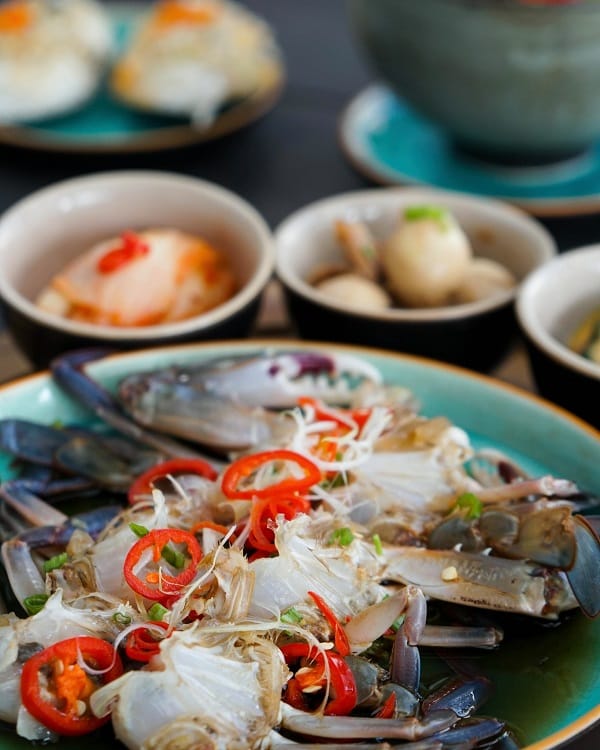
Consuming raw crab does come with some food safety risks. While some may enjoy the taste and texture of raw crab, it’s important to understand the potential dangers that come with consuming this seafood delicacy.
- Raw crab meat can contain harmful microorganisms: Eating raw crab meat can put individuals at risk of foodborne illness. It may contain microorganisms like bacteria, viruses, and parasites that can cause infections and diseases such as bacterial food poisoning and cholera.
- Lung Fluke: Raw crab meat can also be contaminated with lung fluke (Paragonimus westermani), which can cause lung disease. Symptoms include coughing, chest pain, shortness of breath, wheezing, and fever. In severe cases, this can lead to meningitis, swelling of the brain, and even death.
- Risk of Cross-Contamination: Since raw crab meat can easily get contaminated with pathogens during handling, cleaning, and storage, there is a high risk of cross-contamination if proper hygiene practices are not followed. Always buy crab meat from a trusted source and handle it carefully to avoid contamination.
- Digestive Problems: Eating raw crab meat may be hard to digest for some people, which can cause digestive problems like bloating, gas, and stomach pain.
- Allergies: Individuals allergic to shellfish should avoid consuming raw crab meat as it can trigger allergic reactions that can cause itching, swelling, breathing difficulties, and in severe cases, anaphylaxis.
- Parasites: Raw crab meat may also contain parasites such as Anisakis and Vibrio that can cause infections and diseases like anisakiasis and vibriosis.
- Regulation: In most countries, health authorities advise against eating raw crab meat to avoid the risk of foodborne illness and ensure food safety. Following food safety regulations and guidelines when consuming crab meat is important to prevent health risks.
Crab meat is high in protein and low in fat, making it a healthy addition to one’s diet. However, it is essential to ensure that the crab meat is cooked thoroughly to prevent health risks.
Determining the quality and freshness of raw crab meat can be challenging. Consuming crab meat that is not fresh or of poor quality may increase the chances of foodborne illness and result in an unpleasant taste and texture.
Cooking crab meat thoroughly can eliminate the risk of foodborne illness and make it safe to consume. Boiling, steaming, and baking are some methods for cooking crab meat.
Read more:
- Is It Safe To Eat Food Cooked In A New Oven
- Can You Eat Bacon Raw
- Can You Eat Raw Steak
- Food Safety Alert: Danger Of Raw Chicken In Fridge For 7 Days!
Can Raw Crab Harbor Parasites That Can Cause Food Poisoning?
Raw crab has the potential to harbor parasites that can cause food poisoning. One such parasite is Paragonimus, a family of flatworms or flukes that are human parasites, mostly causing problems in the lung, brain, and spinal cord problems. Symptoms can be mild or severe and, in rare cases, fatal.
The crab that is not cooked properly could possibly have a nasty parasite like Paragonimus, which, once ingested, could cause an infection of the lung or other organs and body parts. While cooked crab should be free of any problems from this parasite, it is essential to ensure that raw crab is handled and cooked properly to avoid health hazards.
It is essential to maintain strict temperature controls during the production of soybean milk to prevent the growth and multiplication of bacteria, such as Bacillus cereus, which can cause vomiting and food poisoning. Proper hygiene practices, especially during the cooking and storage of soybean milk and seafood, can help prevent the spread of bacteria and parasites that can cause food poisoning.
Therefore, it is important to be aware of the risks associated with consuming raw crab and take necessary precautions to prevent health issues.
What Are The Symptoms Of Food Poisoning From Raw Crab?
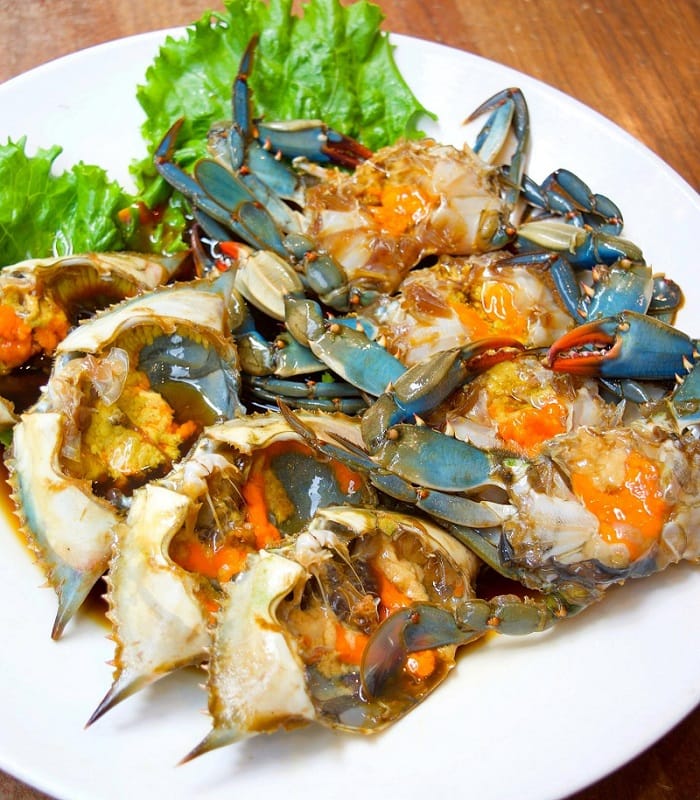
If you’re someone who enjoys indulging in raw seafood, it’s important to know what signs to look out for in case you encounter some bad crab.
- Nausea and Vomiting: Raw crab can cause nausea and vomiting, which are common symptoms of food poisoning. These symptoms can begin within hours of consuming contaminated raw crab meat and last several days.
- Abdominal Pain: Abdominal pain is another common symptom of food poisoning from raw crab. The pain can be sharp or dull and may be accompanied by cramping. Pain can also be felt in the lower back area.
- Diarrhea: Diarrhea is a common symptom of food poisoning from raw crab. It is characterized by loose or watery stools that occur frequently and can be accompanied by abdominal cramping.
- Fever: A fever can occur with food poisoning from raw crab, indicating an immune response to the contaminated food. The fever may be mild or high, depending on the severity of the infection.
- Headache: Some people with food poisoning from raw crab may experience headaches. These headaches can be mild or severe and can last for several days.
- Fatigue: Fatigue is a common symptom of food poisoning from raw crab. It may be accompanied by weakness and a lack of energy, making it difficult to perform daily activities.
- Dehydration: Dehydration can occur with food poisoning from raw crab, especially if symptoms like diarrhea and vomiting are present. It is essential to drink fluids to replace lost water and electrolytes.
- Muscle Aches: Muscle aches are a common symptom of food poisoning from raw crab. These aches can be mild or severe and may be accompanied by joint pain.
- Chills: Chills may occur with food poisoning from raw crab, especially if the fever is present. These chills can be mild or severe and may be accompanied by shivering.
- Skin Rash: A skin rash may be present with food poisoning from raw crab. This rash can be itchy and may be accompanied by hives or blisters. It is essential to seek medical attention if a rash is present.
Proper food handling and preparation techniques are essential to avoid food poisoning from raw crab. Only purchase and consume fresh crab that has been properly stored and cooked. If symptoms persist or worsen, seek medical attention immediately.
What Guidelines Has The FDA Issued Regarding The Consumption Of Raw Crab?
The FDA has issued guidelines regarding consuming raw crab to prevent food poisoning. Raw crab increases the risk of Vibrio infections, especially in older adults, children, and pregnant women. Pregnant women should avoid raw crab and other raw seafood such as oysters, clams on the half shell, and sushi. However, cooked crab is considered one of the best seafood choices for pregnant women, according to the 2017 recommendations from the FDA and EPA.
Imitation crab, which is cooked, is generally safe for pregnant women to eat, but it is important to check if there are other raw products in foods such as sushi before consuming them. The FDA also recommends consuming at least 8 ounces of fish rich in omega-3 fatty acids per week for pregnant women.
Safe food handling and preparation is vital when eating crab or raw meat, including storing live crab in well-ventilated containers or fresh crab in a refrigerator at less than 40°F or well-packed in ice.
It is also essential to keep raw and cooked seafood separate when preparing them and to avoid high-mercury fish such as shark and swordfish during pregnancy.
Tips For Selecting The Freshest Raw Crab
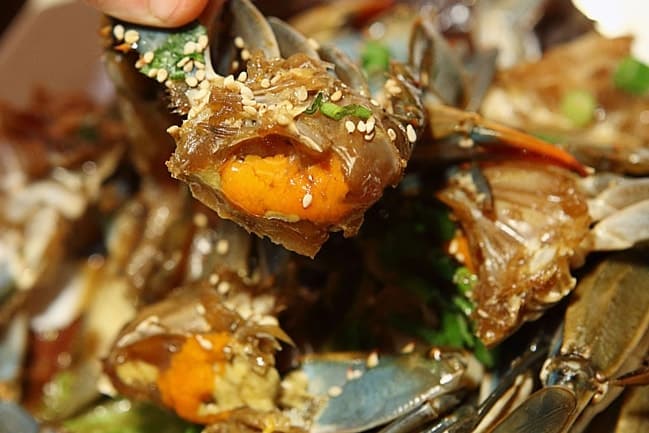
As a seafood enthusiast with years of experience and expertise in selecting the freshest raw crab, I am excited to share my top tips for choosing the best crab for your next meal.
First and foremost, choosing a reputable seafood market or supplier is crucial. Look for a place that has a steady flow of customers, as this indicates that their products are in high demand and are likely to be fresh. Ask the seller when the crab was caught and where it came from. The freshest crab will have been caught within 24-48 hours and come from a reputable source.
When selecting your crab, pay attention to the color and texture of the shell. A fresh crab will have a shiny, bright shell without discoloration or cracks. The texture should be firm but not too hard, and the legs and claws should be intact.
Next, take a close look at the eyes. A fresh crab will have clear, bright eyes that are not sunken or cloudy. If the eyes are cloudy or sunken, this can indicate that the crab has been dead for a while and is not suitable for consumption.
Another important factor to consider is the smell. A fresh crab should not have a strong, foul odor. Instead, it should have a sweet, briny smell reminiscent of the ocean. If the crab smells sour or fishy, it may not be fresh and should be avoided.
It is also important to consider the size and weight of the crab. A larger crab does not necessarily mean it is fresher or better quality. Smaller crabs tend to be sweeter and more tender than larger ones. Additionally, a heavy crab may indicate that it is filled with water, which can affect the taste and texture of the meat.
Lastly, if you have the opportunity to handle the crab before purchasing, take a look at the meat inside. The meat should be firm and white, without discoloration or dark spots. If the meat is soft or discolored, this can indicate that the crab is not fresh.
How Can Cross-Contamination Be Avoided When Preparing Raw Crab?
Cross-contamination can occur when the juices or bacteria from raw crab come into contact with other foods or surfaces, leading to potential health risks. Handling raw crab with care and following proper food safety practices is crucial to avoid cross-contamination. Here are some steps to take:
- Clean and sanitize all surfaces and utensils before and after use. This includes cutting boards, knives, and any bowls or prepared containers.
- Keep raw crab separate from other foods. Use separate cutting boards and utensils solely for the crab to prevent cross-contamination with other ingredients.
- Wash your hands thoroughly with soap and water before and after handling the crab. This will help to prevent the spread of any bacteria that may be present on the crab.
- Store the crab properly. Keep it refrigerated until ready to use, and discard any leftover crab sitting out for over two hours.
When consuming raw crab, there are additional steps to take to ensure safety:
- Purchase high-quality, fresh crab from a reputable source. Avoid any crab that appears slimy, smells off, or has an unusual texture.
- Freeze the crab for at least 48 hours before consuming it. This will kill any potential parasites or bacteria that may be present.
- Serve the crab on a clean, chilled plate to keep it at a safe temperature.
- Always wash your hands thoroughly before and after eating raw crab.
What Does Raw Crab Taste Like?
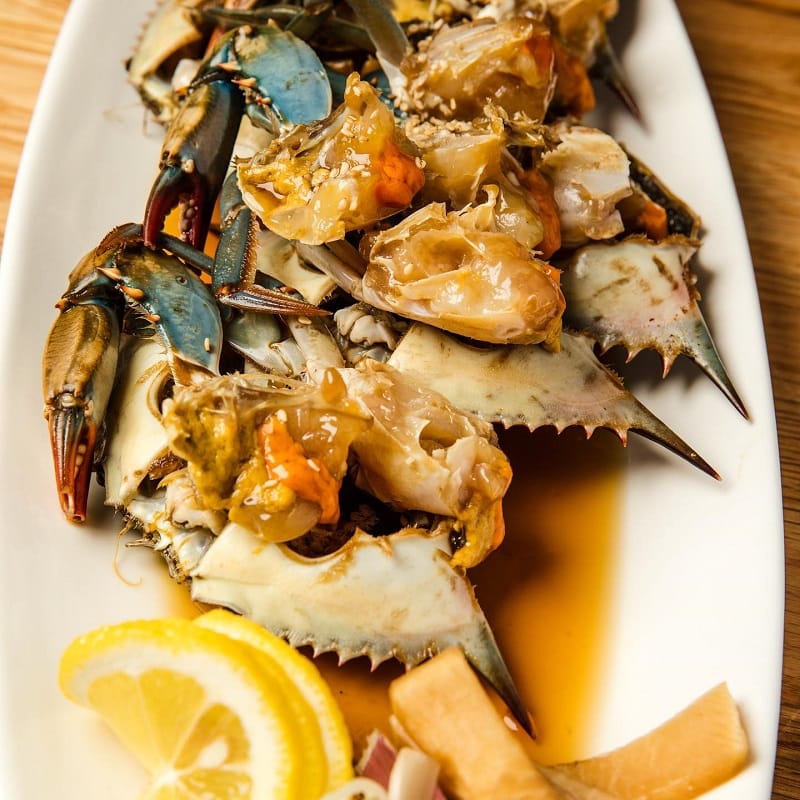
Raw crab marinated in soy sauce is a popular national dish in Korea, known as “rice thief”; it is because you end up eating tons of rice with it as it is so delicious. The dish is made with fresh fat and meaty crab, either a female if you like roe or a male for better flesh. The crab is marinated in a special mix of soy sauce with vegetables and spices that have been boiled and cooled for 2-4 days until the crab soaks up the soy sauce, matures, and becomes savory and sweet. When opened, the crab is served with steamed white rice, and the rice is put inside the crab shell with the roe and mixed.
The taste is savory with the smell of the sea, and the crab meat is tender and sweet. The crab makes the main dish, ‘rice,’ much tastier. The crab roe has a sweet and deep flavor that is the best when mixed with rice. Crab gejang is relatively less exciting because it does not look different from any other raw crab, but many foreigners find it the second most wanted dish when visiting Korea.
The soy sauce marinated version is called ganjang gejang and is generally more popular for its umami flavor, while the spicy version is called yangnyeom gejang. The dish costs around $30 – $50 in Korean restaurants.
Is Crab In Sushi Cooked Or Raw?
Crab is a common ingredient in sushi, but many people are curious whether it is cooked or raw. The answer is that it can be both, depending on the dish. Generally, crab dishes such as crab cakes, crab dip, and crab soup require cooked crab meat. On the other hand, sushi and sashimi often use raw crab meat.
It is important to note that eating raw crab meat that has not been appropriately prepared can cause serious health-related issues. Therefore, one should research and consult a professional if one eats raw crab meat. Additionally, when purchasing crab meat, it is essential to check for a fresh smell and clean color as indicators of freshness. It is always recommended to cook crab meat or have it prepared by a professional chef or restaurant to avoid food-borne illnesses.
In summary, the answer to whether crab in sushi is cooked or raw is that it can be both, depending on the dish and the type of crab used. It is critical to ensure proper preparation and handling to avoid health-related issues.
What Are The Differences Between Eating Cooked Crab And Raw Crab?
When it comes to crab, there are distinct differences between eating cooked crab and raw crab.
Cooked crab is more commonly consumed, posing fewer health risks than raw crab. Cooked crab meat can be enjoyed in various dishes such as crab cakes, crab soup, and crab dip. Cooked crab meat should have a red or orange shell and moist, firm meat that tastes fresh and sweet. Overcooked crab meat appears pink, and the flesh is mushy and fishy in taste, while undercooked crab will have natural dark colors and flesh that is hard to separate from the shell.
On the other hand, raw crab meat is often enjoyed in sushi and sashimi dishes. Raw crab meat has a flaky texture and a sweet taste, but it should be prepared and served carefully to avoid the risk of food poisoning. Eating raw crab meat that has not been appropriately prepared can lead to serious health problems, including nausea, stomach cramps, and diarrhea. It is important to ensure that raw crab meat comes from a reputable source and is prepared thoroughly and carefully to reduce the risk of illness.
How To Cook Crab?
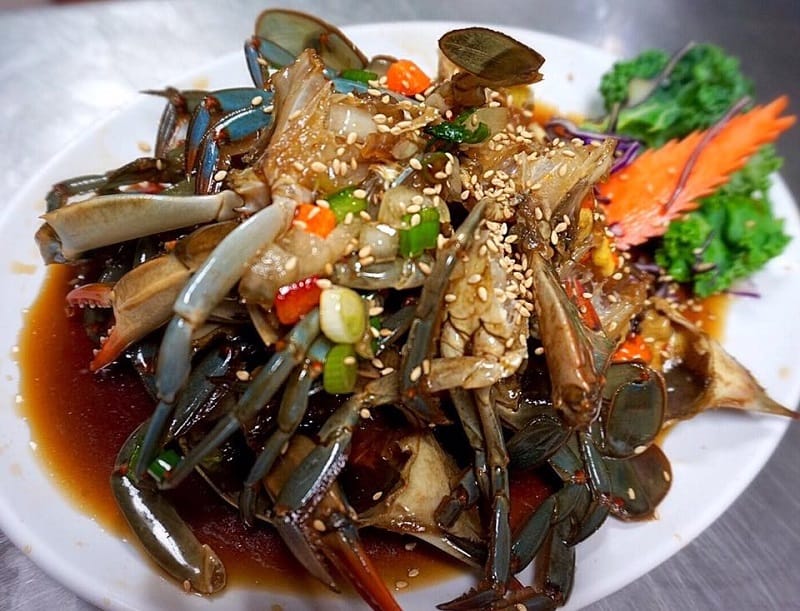
Cooking crab is not as daunting as it may seem. In fact, with a few simple steps, you can have a delicious and impressive seafood dish on your table in no time.
- First things first, it’s essential to prepare the crab for cooking properly. Turn the crab over and lift the small pointed flap to do this. You’ll see a small hole – with some force, insert a sturdy knife or screwdriver into the hole until you feel it touch the other side of the shell. Turn the crab back over and drain the liquid that will run out. This step may seem intimidating, but ensuring the crab is cooked properly is essential.
- Once your crab is ready to go, it’s time to get cooking. Bring a large pan of salted water to a boil, using 30g of salt per liter of water. Place the crab into the boiling water to cook – a 1kg crab should take around 8–10 minutes. Be sure to keep an eye on the crab and set a timer to ensure it doesn’t overcook.
- After the crab has finished cooking, please remove it from the water and leave it to cool before preparing. It’s important not to put the crab into iced water as this will cause it to become waterlogged.
- Now that your crab is cooked and cooled, it’s time to get cracking! Use a pair of kitchen scissors to cut along the length of the crab’s underside. Then, use your hands to pull the shell apart and remove the meat gently. Before serving, remove any of the crab’s internal organs, like the gills.
There are countless ways to enjoy cooked crab – from simple dishes like crab cakes to more complex recipes like crab bisque or crab-stuffed mushrooms. No matter how you serve it, the key is to let the crab’s natural sweetness shine through.
What Precautions Should Be Taken When Cooking Crab?
When it comes to cooking crab, there are a few precautions that you should take to ensure that your meal is not only delicious but also safe to consume.
- First and foremost, ensuring that the crab you are cooking is fresh is essential. This means that you should buy it from a reputable fishmonger or seafood market and check for any signs of spoilage, such as a foul odor or slimy texture. If you are unsure of the freshness of the crab, it is better to err on the side of caution and avoid cooking it altogether.
- Once you have determined that your crab is fresh, the next step is to clean it thoroughly. This involves removing the gills, intestines, other internal organs, and any debris or shells attached to the crab. You can do this using a sharp knife or kitchen scissors, taking care not to puncture the meat.
- Another precaution to take when cooking crab is to avoid overcooking it. Crab meat can become tough and rubbery if cooked for too long, so keeping a close eye on the cooking time and temperature is important. A good rule of thumb is to cook crab for no more than 10 minutes for every pound of crab meat and to avoid boiling it for too long.
- In addition to these precautions, handling crab meat with care is essential to prevent the spread of bacteria. This means washing your hands thoroughly before and after handling raw crab, using separate cutting boards and utensils for raw and cooked crab, and storing leftover crab meat in the refrigerator within two hours of cooking.
How to Safely Store Raw Crab?
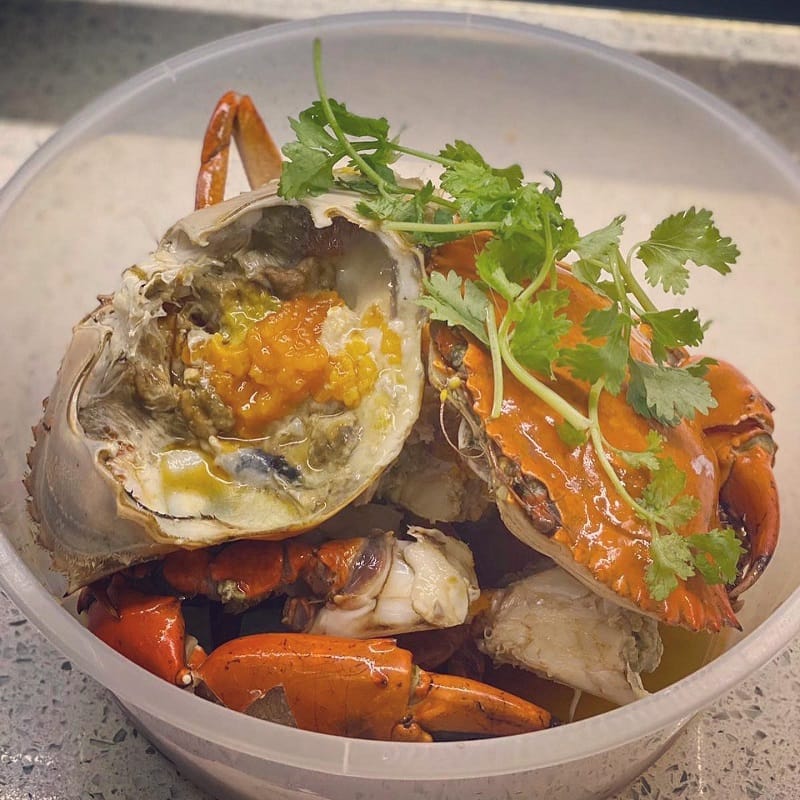
To store raw crab, it’s crucial to follow proper storage guidelines to ensure the safety and freshness of the seafood.
- Firstly, it’s essential to purchase raw crab from a reputable source. Look for suppliers who have a good reputation and adhere to strict standards of hygiene and cleanliness. Once you’ve bought the crab, immediately store it in the refrigerator. The raw crab should never be left at room temperature for more than two hours, as this can encourage the growth of harmful bacteria.
- When storing raw crab in the refrigerator, ensure it’s kept in an airtight container or wrapped tightly in plastic wrap. This helps to prevent any cross-contamination with other foods in the fridge. Ideally, the refrigerator’s temperature should be set at 40°F or below, as this is the optimal temperature for seafood storage.
- It’s important to note that storing raw crab in the freezer is not recommended, as this can affect the texture and taste of the seafood. If you need to store crab for longer, it’s best to cook it first and then freeze it.
- When it comes to handling raw crab, always use clean utensils and surfaces to avoid any contamination. Please wash your hands thoroughly before and after handling raw seafood, and avoid touching your face or other body parts while handling it.
- If you notice any signs of spoilage or discoloration on the crab, such as a foul smell or slimy texture, do not consume it. It’s better to err on caution and discard the seafood.
FAQs About Can You Eat Raw Crab
What Seafood Can You Eat Raw?
When it comes to seafood, there is a debate on which types are acceptable to eat raw. While nearly every fish and shellfish from the sea is edible, it’s important to categorize them based on how they should be prepared.
Tuna and salmon are two of the most popular choices for raw dishes, thanks to their mild flavors and meaty textures. Flounder and sea bass are also great options, with their delicate and mild flavors.
However, crabs, shrimp, lobsters, and crawfish should always be cooked for safety, as they are bottom-dwelling creatures and not picky eaters. While some sushi recipes use raw shrimp, cooking them vastly improves their texture and flavor. Eating a raw crab is nearly impossible, as the meat is too moisture-dense to separate from the shell.
What Nutritional Value Does Raw Crab Offer?
Raw crab offers a range of nutritional benefits. Crab meat is high in protein and low in fat, making it an excellent addition to a balanced diet. It is also a good source of vitamins and minerals, including vitamin B12, copper, selenium, zinc, and sodium. Crab is particularly beneficial for its high concentration of long-chain omega-3 fatty acids, which have been linked to anti-inflammatory effects and heart health.
Additionally, crab is a rich source of selenium, a mineral required by selenoenzymes and selenoproteins that play a role in the antioxidant system. Despite its many benefits, people with shellfish allergies should avoid crab meat entirely, and those with heart and hypertension conditions should not overconsume it. Raw crab is a nutrient-dense food that can provide a range of health benefits when consumed as part of a balanced diet.
What Types Of Shellfish Are Unsafe To Consume Raw?
Certain types of shellfish are unsafe to consume raw.
- Raw oysters and clams are of particular concern as they can contain harmful bacteria such as norovirus and hepatitis A. Those with weakened immune systems, cancer, hemochromatosis/hemosiderosis, steroid dependence, and achlorhydria are at the highest risk and are advised to eat oysters or clams only if thoroughly cooked.
- Crawfish, crabs, shrimp, and lobster should also be cooked because they may contain bacteria and parasites from the water they live in or from handled with unclean hands. Cooking shellfish kills harmful organisms and makes them safer to eat. It’s important to reduce the risk of illness and limit exposure to bacteria, viruses, and parasites found in raw shellfish, especially if one has any health conditions mentioned above.
Eating raw shellfish should be avoided, and cooked shellfish should be chosen when dining out.
What Kind Of Seafood Is Raw Crab Categorized As?
Raw crab is categorized as shellfish, a type of seafood that includes crustaceans and mollusks. Crustaceans like crabs, shrimp, and lobsters have hard outer shells and segmented bodies with jointed limbs. Raw crab is often a delicacy in many cultures and a popular ingredient in dishes such as sushi and ceviche.
Overall, raw crab belongs to the category of shellfish, which is a valuable source of protein and nutrients in a balanced diet.
What Is Vibrio Bacteria, And How Can It Affect Raw Crab Consumers?
Vibrio bacteria is a harmful bacteria found in raw or undercooked seafood, particularly in shellfish like oysters, mussels, and scallops. While vibrio illnesses from fish are less common, they can still happen. Vibrio can also spread through open wounds that come in contact with raw or undercooked seafood.
Ingesting vibrio-contaminated seafood can cause vibriosis, which can lead to symptoms such as watery diarrhea, stomach cramping, nausea, vomiting, fever, and chills. The CDC estimates that vibriosis causes 80,000 illnesses annually in the United States, with over half of these caused by eating contaminated food. It is crucial to cooking shellfish to an internal temperature of 145°F for 15 seconds to destroy vibrio and other harmful bacteria.
To minimize your risk of contracting vibriosis, eating well-cooked shellfish is recommended, avoiding harvesting shellfish exposed to the sun for more than an hour, and checking for closures and advisories at local health departments before harvesting shellfish. It is also advisable to seek medical attention if you experience any symptoms of vibriosis after consuming raw or undercooked seafood.
Can People With Seafood Allergies Eat Crab?
People with seafood allergies may or may not be able to eat crab. Crab is a crustacean, along with shrimp and lobster, which are known to cause allergic reactions in some people. Shellfish allergies affect nearly 7 million Americans and are among the most common food allergies. Within the shellfish family, the crustacean group causes the greatest allergic reactions.
However, many shellfish-allergic people can eat mollusks such as scallops, oysters, clams, and mussels with no problem. Those with shellfish allergy symptoms need to consult an allergist before eating any shellfish. Diagnosing shellfish allergies can be complicated and may require skin-prick tests, blood tests, or an oral food challenge conducted in a doctor’s office under strict supervision.
People with severe shellfish allergies should take precautions when dining out and may want to avoid seafood restaurants, as cross-contamination can occur. It is important to read food labels carefully and avoid foods that contain shellfish. Ultimately, whether or not to eat crab with a seafood allergy should be made in consultation with a healthcare professional.
Conclusion
In conclusion, while it may be tempting to try raw crab, it is not worth the potential risks to your health. Always ensure that the seafood you consume is cooked properly to avoid potential health problems. So, the next time you are at a seafood restaurant and are tempted to try something new, remember that it is always better to err on caution and stick to cooked seafood.
We hope this post has been helpful in answering the question of whether can you eat raw crab. Let us know how it turns out by leaving a comment below.
References:
- https://www.fda.gov/food/buy-store-serve-safe-food/selecting-and-serving-fresh-and-frozen-seafood-safely
- https://www.medicalnewstoday.com/articles/322137
- https://www.cdc.gov/vibrio/food.html
- https://www.stylecraze.com/articles/crab-nutrition/

Hey readers! Chip Holland here, and I’m a Manager of this website. My passion for writing about it only matches my passion for BBQ. Follow my blog for mouth-watering recipes, tips, and tricks for the perfect smoke, grill, and BBQ. I’m sure you won’t be disappointed!
